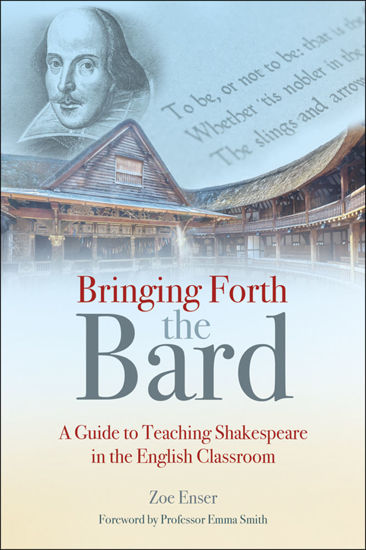- Home
- Publications
- A New Title from Crown House Publishing Limited: Bringing Forth the Bard: A guide to teaching Shakespeare in the English classroom
A New Title from Crown House Publishing Limited: Bringing Forth the Bard: A guide to teaching Shakespeare in the English classroom
Author: Zoe Enser
ISBN 9781785836299
April 2022
www.crownhouse.co.uk

Widening the lens on the teaching of Shakespeare in the English classroom
Regardless of how you personally perceive Shakespeare’s work, there is no doubt his appeal and influence is enduring. His plays have been adapted for film an astonishing number of times, with at least 525 listing him in the writing credits. His works are available in print in over 100 different languages, and volumes of his plays and poems dominate many collections.
The English national curriculum continues to stipulate the inclusion of two Shakespeare plays for study at Key Stage 3 and one at Key Stage 4 and his work continues to be studied at the A level in most literature courses. But whilst he is still prevalent on school curriculums across the globe, the importance of his work goes beyond the school room; over the centuries we have turned to Shakespeare, as we have to other fiction, to seek an understanding of ourselves and in so doing we have come to project some of his ideas onto our everyday lives.
References to the Bard have also infiltrated our everyday speech, cropping up in idioms and references which help construct the way we see the world. The British rapper Stormzy even appears to be a fan, crowning himself a troubled king of the Shakespearean ilk with his Heavy is the Head album.
Fully understanding his oeuvre – with 37 plays, 159 sonnets and four longer poems – is a vast undertaking. To study everything written about Shakespeare’s life, world and work is a challenge on an epic scale; recent estimates say it would take over 27 years just to read what has been written about Shakespeare contained in the Library of Congress!
In the current educational climate, however, having a deep understanding of your curriculum and how it builds over time is key. Particularly in English literature and other humanities subjects, the breadth of knowledge required to make significant curriculum decisions and design effective teaching opportunities really challenges teachers to know their content thoroughly. Students need to be able to develop conceptual responses to Shakespeare’s work, which means teachers need to understand what that means too. Educators therefore also need to have the opportunity to explore, debate and discuss those texts and ideas they want to include in the curriculum, as well as be able to examine how the best approaches apply to that content and their classrooms.
In her new book Bringing Forth the Bard, Zoe Enser – a former head of English with over 20 years’ classroom teaching experience – has put together a guide to teaching Shakespeare for English teachers, linking together the golden threads which run through his work and highlighting how teachers can best explore these with students.
“This book is an opportunity for busy teachers to be able to access the information they need in order to enrich their teaching beyond a single play and begin to unpick the threads of Shakespeare’s work as a whole, in a way that will enrich their explanation and understanding of the texts. It is an opportunity for them to widen their knowledge – and that of their students, who we want to empower to engage with the ideas and allusions both within and to his work, which remain prevalent throughout much of the English-speaking world.”
Underpinned by Zoe’s academic research into the subject, at both undergraduate and master’s level, each chapter of the book includes tips on how to bring Shakespeare’s plays to life in the classroom, and features case studies from practising teachers in a range of contexts to illustrate how they can ensure that their students develop an appreciation of his work – moving beyond the requirements of exams and empowering them to engage in the discussion around his influence and enduring appeal.
For more look here.
Zoe Enser was a classroom teacher for 20 years, during which time she was also a head of English and a senior leader with a responsibility for staff development and school improvement. She is now the lead specialist English adviser for Kent working with The Education People and is an evidence lead in education (ELE).
A New Title from Crown House Publishing Limited: Bringing Forth the Bard: A guide to teaching Shakespeare in the English classroom
Lila and the Dragon Helps Students Discuss Complex Issues
Brandon W. Wallace and Calmsie, United States of AmericaReady to Run Launches ELT Video Featuring Neurodiversity
The Vocabulary Detective, reviewed by the Author
David Hastings, New ZealandThe Wolf was Not Sleeping (Police Care UK edition): Supporting the Children of First Responders with a Heart-warming Bedtime Story
Avril McDonald, New ZealandTeaching Critical Thinking in the Context of Political Rhetoric A Guide for Classroom Practice
Joseph Sanacore, Professor, Long Island University, Brookville, NY